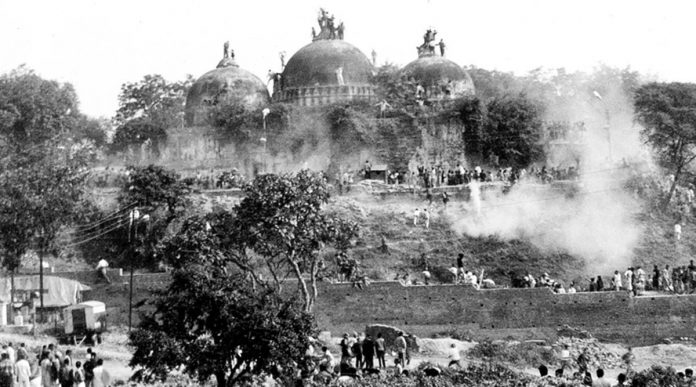Zainab Ashraf siyasat.net
Finally, the day has come for which the majoritarian population had been waiting for from past 451 years. There was a choice between 3rd and 5th of August to lay the foundation stone for the construction of Ram temple and without any delay, 5th of August was selected because it marks the first anniversary of abrogation of Article 370.
Hence, there were two reasons to celebrate this day but is this really a matter to celebrate? Neither the abrogation of Article 370 nor the permission to construct Ram temple on the disputed territory was just.
The Supreme Court of India give several reasons before giving final verdict in favour of the construction of temple but among all, the two of them are utmost important. The first reason seems quite biased where the Supreme court says, “The faith of the Hindus that Lord Ram was born at the disputed site where the Babri Masjid once stood cannot be disputed.”
Does it mean that the Hindus can claim any property just by saying that their deities were born on that land and so anything over it should be razed? There was literally no concrete evidence to prove that on that particular piece of land Ram was born.
The second reason is equally absurd, the apex court says, “The underlying structure below the disputed site at Ayodhya was not an Islamic structure, but the ASI (the Archaeological Survey of India has not established whether a temple was demolished to build a mosque.”
Now, this statement is in itself contradictory. When it is not confirmed that the ruins of the previous structure was of a temple or not then how come the Supreme court can go on to say that it is not sure whether a ‘temple’ was demolished or not? Does it mean that any non-Islamic structure simply belongs to the Hindu rulers?
Have the people of India forgotten that India has a rich history and it was under several rulers from different faiths other than the Islam? Therefore, to get the reliable information, the two archeologists, Supriya Varma, professor of archeology at Jawaharlal Nehru University and Jaya Menon, head of History department at Shiv Nadar University were appointed by Sunni Waqf Board to cross check the findings of the ASI because the body has to report directly to the Ministry of Culture which was under the NDA government in 2003.
Hence, there was a pressure over the ASI to reinforce the Hindu right-wing narrative that Mughal emperor Babur’s general Mir Baqi destroyed a temple to build a mosque on the spot where Ram was born.
To burst this oral tradition, these two observers went to site for continuously four months and came out with several key factors which also raises questions on the working of the ASI. The first of all, the remains of a previous structure which were found beneath the Babri mosque is not necessarily be of a temple, as claimed by the ASI. There were five things in total beneath the disputed territory, one is the western wall, the second are the 50 pillar bases, the third are the architectural fragments, the fourth are the bones of both human and animals and the fifth are the ceramics.
The last two evidences are not recorded by the ASI but in this case they were recorded after the complaint made by the observers because initially, the body were throwing them away. Now, let’s begin with the first finding, as per the observers, the western wall is a feature of a mosque. It is a wall in front of which you say namaaz. It is not the feature of a temple. Temple has a very different plan. It means that probably there could be a mosque beneath the Babri mosque.
Next are the pillars, now as per the observers, they were actually not pillars rather they were pieces of broken bricks and they had mud inside them. Obviously, there is no way a pillar which has mud inside it can properly stand. Regarding the third piece of finding, the architectural fragments, the ASI found some 400-500 fragments, out of these 12 are the most pivotal and of these 12, none of the fragments were found during the excavation.
They were recovered from the debris lying above the lime floor of the masjid when it was demolished by the Rashtriya Swayamsevak Sangh (RSS) members in December 1992. It means that they could have come from anywhere and there is no way of dating the stones.
In addition to all this even the standard report of the ASI have not mention anything which can establish the fact that there was a temple. In the last paragraph of the report, they said that given the evidence of this western wall, and pillar bases, and some architectural fragments, there was a temple underneath the Babri Masjid. That’s all, they concluded the report in just three lines.
Now, the question arises if there was not a temple then exactly what was there? To answer this question, we have to go beyond the 12th century, down to the levels of the 4th to 6th century, i.e. the Gupta period, there seems to be a Buddhist stupa. So, there was Buddhist rule over here, and that is even Alexander Cunningham, the first Director General of the ASI had said during his tenure (1861-62). He found three mounds near the Babri mosque, the two of them have some kind of Buddhist stupa structure and one of them has a Vihara that too outside the boundary of the Babri masjid.
Hence, it clearly shows that a Buddhist community was here, roughly from the 2nd century BC to 6th century AD. If this is the case then the site could have been better utilized by constructing a museum where we could show cased our rich traditions and cultures. This would ultimately help in generating the employment opportunities and of course to boost the economy of Ayodhya.
(www.siyasat.net is Ahmedabad,Gujarat, india based Website)































